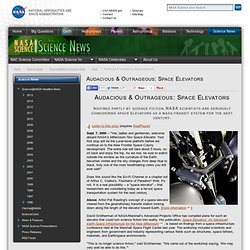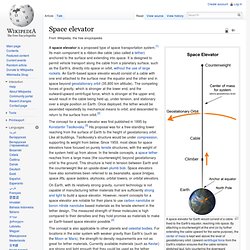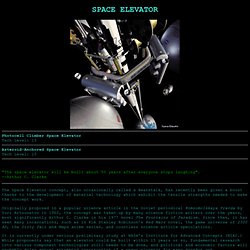

How do spacecraft re-enter the Earth. Launching a spacecraft into space is one thing.

Bringing it back is another. Spacecraft re-entry is tricky business for several reasons. When an object enters the Earth's atmosphere, it experiences a few forces, including gravity and drag. Gravity will naturally pull an object back to earth. But gravity alone would cause the object to fall dangerously fast. Oil spill robot. Page 2 Page 3 Page 4. Space_elevator_structural_d.jpg 381×657 pixels. Top 10 Technologies Inspired by Nature - Page 2.
How fast can you go (Space Travel)? - Travel Forum - Share Travel Guides, Travel Maps, Travel Photos, Travel Deals. Deprecated: Assigning the return value of new by reference is deprecated in /home/journey/public_html/forums/showthread.php on line 606 Deprecated: Assigning the return value of new by reference is deprecated in /home/journey/public_html/forums/showthread.php on line 1004 Deprecated: Assigning the return value of new by reference is deprecated in /home/journey/public_html/forums/showthread.php on line 1009. Audacious & Outrageous: Space Elevators. Inspired partly by science fiction, NASA scientists are seriously considering space elevators as a mass-transit system for the next century.

Listen to this story (requires RealPlayer) Sept. 7, 2000 -- "Yes, ladies and gentlemen, welcome aboard NASA's Millennium-Two Space Elevator. Your first stop will be the Lunar-level platform before we continue on to the New Frontier Space Colony development. The entire ride will take about 5 hours, so sit back and enjoy the trip. World's Fastest Things. The Spaceward Foundation. Space Elevator. PBS Airdate: January 9, 2007 NEIL DEGRASSE TYSON: You're watching NOVA scienceNOW. Space Elevators. Space Elevators Interview with Mr. Ben Shelef - founder of the Spaceward Foundation which is a public-funds non-profit organization dedicated to furthering space science and technology in the public mindshare and in educational curriculums.
Space Elevator Conference. The 2014 conference will be held at the Museum of Flight in Seattle, Washington August 22-24. Register now to take advantage of the early-bird registration rates. Conference events included: 1-Day Family Science Fest Date: Saturday, August 23, 2014Time: 10am to 5pmCost: Included with Museum of Flight admissionSE 101: Introduction to the Space Elevator conceptSE 201: You've been to SE 101, now learn more details about the SE applications, challenges, and opportunitiesRobo Climb: A family-focused event for kids of all ages featuring a robotic climber competitionMore activities are being planned this yearRead more about the Family Science Fest 3-Day Technical Program.
The Space Elevator Reference. TEDx Talk: An Elevator to Space © Alan Chan.

Space Elevator Ribbon" How Space Elevators Will Work" When the Space Shuttle Columbia lifted off on April 12, 1981, from Kennedy Space Center, Fla., to begin the first space shuttle mission, the dream of a reusable spacecraft was realized.

Since then, NASA has launched more than 100 missions, but the price tag of space missions has changed little. Whether it is the space shuttle or the non-reusable Russian spacecraft, the cost of a launch is approximately $10,000 per pound ($22,000 per kg). A new space transportation system being developed could make travel to Geostationary Earth Orbit (GEO) a daily event and transform the global economy.
A space elevator made of a carbon nanotubes composite ribbon anchored to an offshore sea platform would stretch to a small counterweight approximately 62,000 miles (100,000 km) into space. Mechanical lifters attached to the ribbon would then climb the ribbon, carrying cargo and humans into space, at a price of only about $100 to $400 per pound ($220 to $880 per kg). Space elevator. A space elevator for Earth would consist of a cable fixed to the Earth's equator, reaching into space.

By attaching a counterweight at the end (or by further extending the cable upward for the same purpose), the center of mass is kept well above the level of geostationary orbit. Upward centrifugal force from the Earth's rotation ensures that the cable remains stretched taut, fully countering the downward gravitational pull. Once above the geostationary level, climbers would have weight in the upward direction as the centrifugal force overpowers gravity.
Space Elevator Enthusiasts Push On despite Lengthy Time Frames and Long Odds. SEATTLE—“I think building an elevator to space is maybe the best thing I could do in the world,” Michael Laine says.

His company, Liftport, has just raised over $62,000 on Kickstarter to build robot climbers on a skyward cable—an early step toward his eventual goal of putting a space elevator on the moon. A space elevator is just what it sounds like—a capsule that travels to and from space along a track or tether to provide reliable access to orbit. Behind Laine is the cavernous Great Gallery at Seattle's Museum of Flight, where dozens of aircraft are on display, chronicling the human adventure of flight. Meeting in a nearby conference room are about 40 space enthusiasts, in town for the annual Space Elevator Conference hosted by ISEC, the International Space Elevator Consortium.
Some of them have sacrificed their careers, credit ratings or savings accounts—all in pursuit of a simple concept that has thus far proved impossible in practice. But it's not all starry-eyed optimism. SPACE ELEVATOR. The basic principle of a Space Elevator is fairly simple to envision.

Tie a string to a baseball and twirl the string above your head. The string will remain taut and straight as long as the twirling motion is in effect. The Earth is spinning far faster than your hand could ever manage, about 1000 miles per hour. If you anchored an incredibly strong wire to Earth’s surface at the equator, then attached the other end to a large enough mass (say, a small asteroid) to keep it taut, you end up with a perfectly-straight railroad track right into space. The Space Elevator’s center of mass would be at geosynchronous orbit, approximately 22,300 miles above the equator, helping to keep the entire construct fixed over a stable position on Earth.
Once the cable is set up, elevators can ride it up and down via magnetic rails, delivering cargo straight into orbit.